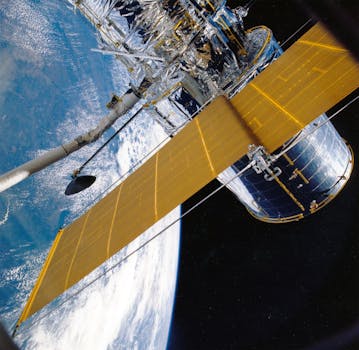LEO Satellites: Revolutionizing Global Connectivity with WordPress

LEO Satellites: Revolutionizing Global Connectivity with WordPress
Low Earth Orbit (LEO) satellites are transforming the way we communicate and access information, and WordPress is at the forefront of this revolution. LEO satellites are a type of satellite that orbits the Earth at an altitude of around 160 to 2,000 kilometers, which is much lower than traditional geostationary satellites. This lower altitude enables LEO satellites to provide faster and more reliable communication services, making them ideal for a wide range of applications, including global connectivity, satellite imaging, and navigation.
LEO satellites are being used to provide broadband internet access to underserved communities around the world. Companies like SpaceX, OneWeb, and Amazon’s Kuiper Systems are launching constellations of LEO satellites to provide high-speed internet access to remote and underserved areas. This is especially important for areas where traditional fiber-optic cables are not available or are too expensive to install. With LEO satellites, people in these areas can access the internet at speeds of up to 1 Gbps, which is comparable to the speeds available in urban areas.
WordPress is playing a crucial role in the development and deployment of LEO satellites. Many companies involved in the LEO satellite industry use WordPress to build their websites and manage their online presence. WordPress provides a flexible and customizable platform for building websites, which is essential for companies that need to showcase their products and services to a global audience. Additionally, WordPress provides a wide range of plugins and themes that can be used to build complex websites, including e-commerce sites, blogs, and news sites.
How LEO Satellites Work
LEO satellites work by transmitting and receiving data to and from Earth-based stations. The satellites are equipped with transponders, which are devices that receive and retransmit signals. The transponders on LEO satellites are designed to operate at very high frequencies, typically in the range of 20-30 GHz. This allows them to transmit large amounts of data quickly and efficiently. The satellites also have onboard storage, which enables them to store data temporarily before transmitting it to the ground.
LEO satellites are launched into space using rockets, and once they reach their desired altitude, they begin to transmit and receive data. The satellites are equipped with solar panels, which provide power, and batteries, which store energy for when the satellites are in the Earth’s shadow. The satellites also have propulsion systems, which enable them to maintain their orbit and adjust their position as needed.
Benefits of LEO Satellites
LEO satellites have several benefits, including low latency, high-speed data transfer, and global coverage. The low altitude of LEO satellites means that they have a lower latency than traditional geostationary satellites, which makes them ideal for real-time applications such as video conferencing and online gaming. The high-speed data transfer capabilities of LEO satellites also make them suitable for applications such as cloud computing and big data analytics.
LEO satellites also provide global coverage, which means that they can provide services to anyone, anywhere in the world. This is especially important for areas where traditional communication services are not available or are unreliable. With LEO satellites, people in these areas can access the internet, make phone calls, and send messages, which can be a lifesaver in emergency situations.
Challenges Facing LEO Satellites
Despite the many benefits of LEO satellites, there are also several challenges facing the industry. One of the biggest challenges is the high cost of launching and operating LEO satellites. Launching a satellite into space can cost tens of millions of dollars, and operating a constellation of satellites can cost hundreds of millions of dollars per year. Additionally, the regulatory environment for LEO satellites is still evolving, and there are many uncertainties surrounding issues such as spectrum allocation and orbital slots.
Another challenge facing the LEO satellite industry is the risk of collisions and space debris. As more and more satellites are launched into space, the risk of collisions increases, which can create a significant amount of space debris. This debris can pose a hazard to other satellites and spacecraft, and can even cause damage to the Earth’s atmosphere.
Conclusion
In conclusion, LEO satellites are revolutionizing the way we communicate and access information. With their low latency, high-speed data transfer, and global coverage, LEO satellites are ideal for a wide range of applications, including global connectivity, satellite imaging, and navigation. WordPress is playing a crucial role in the development and deployment of LEO satellites, and many companies involved in the industry use WordPress to build their websites and manage their online presence. While there are several challenges facing the LEO satellite industry, the benefits of these satellites make them an essential part of our increasingly connected world.





